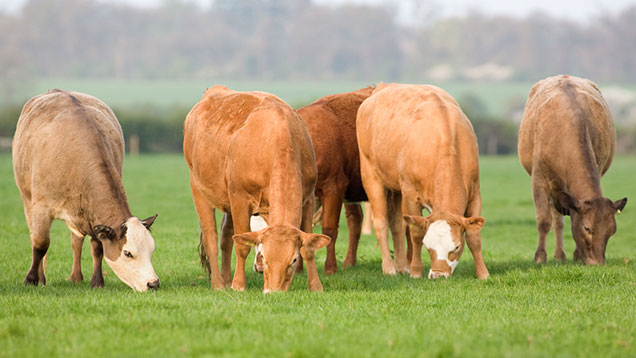6 top tips for turning out beef cattle early
 © Tim Scrivener
© Tim Scrivener Beef farmers are being encouraged to turn out stock early to cut feed costs and improve grass growth.
According to Liz Genever, Eblex beef and sheep scientist, when fields are monitored and a grazing plan is put in place, farmers can turn out before May or June.
She says beef producers could save £1 an animal a day when cattle are out at grass compared with when they are housed.
See also: Push for early winter growth of beef cattle
“It doesn’t mean chucking all the cows out in mid-February; careful planning is required,” she says.
Dr Genever has put together six areas to consider when turning out early.
1. Planning
Monitor fields from late winter, so decisions can be made about grass availability.
South-facing fields not grazed from late September/October with good soil structure and fertility would most likely be suitable for earlier turnout.
Growing cattle should be allocated at least 3% of their bodyweight, so a 300kg growing animal needs about 9kg DM/day and in March grass may be growing 5-15kg DM/ha/day, which indicates the required stocking rate if a wedge of grass is not built up.
2. Measure and monitor sward heights
Based on standard sward heights, the ideal pre-graze sward height for beef cattle early in the season is 8-10cm, with 5-6cm being the ideal post-grazing sward height. These are targets for rotational grazing.
For set stocking, 5-6cm is the target. But care is needed to make sure the stocking rate fits the growth.
A compressed sward stick can be used to assess pasture cover measured in kilograms of dry matter a hectare. It works like a plate meter and measures the density of the sward.
It is very useful when allocating grass based on intakes.
For example, when a field is measured at 2,000kg DM/ha (about 8cm) and the target residual is 1,500kg DM/ha (about 5cm) then there is 500kg DM of available grass.
This means each hectare would support 10 growing cattle for nearly six days (500 divided by nine equals 56, 56 divided by 10 growing cattle equals 5.6 days).
This approach can be used when planning how many animals to turn out on to what area.
Sward heights should be assessed weekly.
3. Avoid sward damage
The crucial aspect of earlier turnout is to do everything possible to prevent damage to the sward through poaching.
Therefore, matching stock type (weight and size) and stocking density to the soil conditions of the fields is extremely important – for example, the heavier the soil, the lighter the stock.
4. Consider rotational grazing
Rotational grazing allows grass to recover once the animals have been moved to the next field. The speed of the rotation will depend on grass growth and the wedge that has been built.
For example, if 10ha is available and grass growth was about 10kg DM/ha/day. The pre-graze cover is 2,000kg DM/ha and target residue is 1,500kg DM/ha, with a use rate of about 75%.
If the area could be split into eight paddocks (either with electric fencing or by using established field boundaries), each of about 2.5ha and each grazed for seven days, it could support 17 300kg growing cattle (allocated 9kg DM/day) for 56 days.
So if this was started in March, it could last until end of April and it is likely that grass growth will increase in line with their increasing demand as they get heavier.
See also: Give grass a boost of N if planning for early turnout
It may be that the animals need to move through the fields faster as the 6th, 7th and 8th paddocks may be getting away by the time you want to graze them.
This means leaving the residual higher. There are a variety of solutions to this problem, but always remember it is all about supply and demand.
5. Strategic use of fertiliser
Strategic application of nitrogen fertiliser or slurry in late February/early March will help to stimulate early growth.
Soil temperatures higher than 5C for five days will lead to a good response to nitrogen – about 12kg DM for every 1kg N.
An application of about 50kg N/ha (40 units/acre) to areas that favour early growth – ie, not grazed hard over the winter, south-facing slopes, well-drained, light soils with good fertility – will achieve the best results.
6. Think about grazing silage fields
During the winter, ryegrass produces a new leaf about every 30 days so it takes 90 days for all its leaves to be replaced.
It should be considered whether all fields should be grazed to stimulate growth and then fields can be shut up
